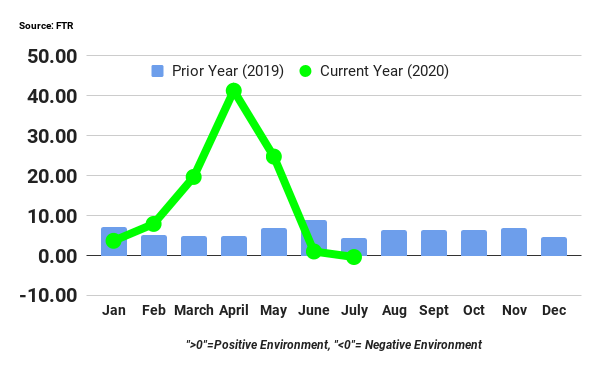
The FTR Shippers Conditions Index (SCI) fell into negative territory for the first time since August 2018, with a -0.36 reading. After a huge positive spike as COVID-19 impacted freight movement, the SCI now reflects a continued weakening of shippers’ market conditions. Freight volume and utilization were actually more favorable to shippers in July, but the rate environment swung from significantly positive in June to a significantly negative reading in July.
After a near term slightly negative view for the SCI, FTR expects potential increased capacity to push the index back into the positive range by Q4 and through 2021. However, continued high capacity utilization is a significant risk.
Todd Tranausky, vice president of rail and intermodal at FTR, commented, “It has been harder than expected to bring truck drivers back into the driver pool. This has created tightness in the truckload market that has bled over into the intermodal space. It is unknown how long the present situation will last, as it may be related to retail restocking or part of a longer-term shift in spending away from services and toward goods. A shift toward goods would result in stronger freight demand and worse conditions for shippers.”
The September issue of FTR’s Shippers Update, published September 9, details the factors affecting the June Shippers Conditions Index and provides the forecast for this index through June of 2021. The additional commentary in this report analyzes the risks to the freight market from inventories-to-sales ratio disparities in the supply chain resulting from the COVID-19 pandemic.
The Shippers Conditions Index tracks the changes representing four major conditions in the U.S. full-load freight market. These conditions are: freight demand, freight rates, fleet capacity, and fuel price. The individual metrics are combined into a single index that tracks the market conditions that influence the shippers’ freight transport environment. A positive score represents good, optimistic conditions. A negative score represents bad, pessimistic conditions. The index tells you the industry’s health at a glance.







